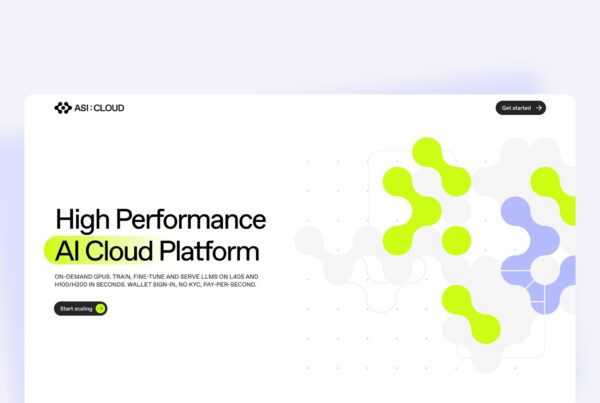This is the third article in an informational series covering ASI Chain; a revolutionary Layer-1 infrastructure purpose-built for advanced decentralized artificial intelligence (AI) applications.
Whether you’re a developer exploring agentic systems, a blockchain enthusiast looking for exposure to AI-native economies, or a researcher working on open models and data coordination, this series is designed to give you the clarity and context you need. We will unpack the motivations, architecture, real-world utility, and long-term vision behind ASI Chain so you can understand what makes it different, and why it matters.
In case you missed it, go ahead and explore the first article in our series that explains why we’re building ASI Chain.
Introduction
ASI Chain is a purpose-built Layer 1 designed to carry not only tokens or simple contracts, but living systems of computation where intelligent agents reason, transact, and coordinate at scale. The chain achieves this by pairing a meta-theoretical execution kernel, MeTTa, with a sharded, heterogeneous consensus substrate.
In this article, we explain how those pieces fit together.
This article explores the technical foundations of ASI Chain, focusing on its modular design, sharded execution, and innovative consensus mechanisms. These are native elements, purpose-built to support not only a high-performance blockchain in the traditional sense, but also a new class of applications built on top of it: intelligent agents that learn, adapt, reason, and interact on-chain.
The Problem
The limitations of legacy blockchains such as Ethereum or Solana become apparent when tasked with executing agentic or AI-native workloads. These chains were designed for static logic and token-centric economies. Their consensus algorithms are monolithic, their execution environments are sequential, and their state models are globally shared. This architecture is incompatible with high-throughput, concurrent, cognitive computation. ASI Chain, although built to handle and do everything a blockchain can and should do, was designed from the ground-up to match the demands of AI applications.
AI apps, particularly decentralized ones, demand much more: concurrent execution, symbolic reasoning, compositional logic, dynamic memory, and fault-tolerant coordination between agents. These workloads are not just compute-intensive; they are semantically rich. Embedding AI into chain infrastructure requires more than performance improvements. It requires an entirely new architecture.
This is the purpose of ASI Chain: to be the Layer-1 blockchain that’s not only better than other blockchains in the transfer of value and deployment of logic, but also to be explicitly designed to host autonomous, intelligent systems.
Its design introduces three core advances:
- A symbolic execution kernel (MeTTa) capable of reasoning, adaptation, and code evolution – meaning developers can write smart contracts that learn, evolve, and interoperate, bringing AI logic on-chain for the first time ever.
- Sharded, modular computation that allows the network to scale horizontally (like adding more lanes to a highway) so heavy AI tasks and simple transactions can run in parallel with no congestion.
- A flexible consensus layer for fault-tolerant, high-throughput coordination, so every task has its own tailored consensus mechanism, be it trading, data integrity, or coordination.
Let’s explore all three of these elements and provide you with an overview of the system architecture that makes them work together at scale.
With its unique architecture, ASI Chain sets the standard for throughput, composability, and agent-native capability, positioning it as the foundation for scalable on-chain intelligence.
From Virtual Machines to a Meta-Theoretical Kernel
Conventional chains fix semantics in a virtual machine. They tell you how to compute. MeTTa, the kernel at the base of ASI Chain, is different. It’s a meta-theoretical environment where theories of computation are defined, reasoned about, and executed.
In MeTTa, code, data, logic, and memory live in one symbolic space. Programs can reflect on themselves, generate interpreters and type systems from formal specifications, and operate natively over semantic memory. This is the right substrate for agents that must justify and adapt their behavior on-chain.
The technical lever is the notion of Graph-Structured Lambda Theories, or GSLTs. A GSLT presents both the term language and its rewrite semantics, including the reduction strategy, as first-class objects. From such a presentation, the toolchain can automatically generate an efficient interpreter and a sound, modal type system that captures properties like possibility and necessity of reductions. This closes the loop between specification, execution, and reasoning.
Sharding as Fault-Tolerance Units
ASI Chain treats sharding as a tree of fault-tolerance domains.
In blockchain terms, sharding means splitting the network into multiple smaller parts (shards), each capable of processing its own set of transactions and computations. Instead of forcing the whole chain to handle every operation, shards let the workload run in parallel.
On ASI Chain, the coordinator (parent) shard routes transactions to the appropriate execution shard (children) when they only involve that shard. If a transaction spans multiple shards, the coordinator ensures all shards reach agreement. It provides a higher-order consensus context when a transaction spans sibling shards. This gives a clean place to draw security boundaries, to localize performance characteristics, and to scale without sacrificing global composability. The same channel-oriented model that powers agent communication makes it natural to stitch shards into a larger network, and even to treat external networks as shards when interoperation requires it.
This approach generalizes beyond a single chain. Because the MeTTaCycle architecture compiles theories into portable interpreters and because the runtime speaks to other systems through channels, ASI Chain nodes can participate in heterogeneous environments and export “data on chain” or “agents on chain” capabilities into other ecosystems.
ASI Chain is built on a sharded architecture, but it goes far beyond simple data partitioning. On ASI Chain, shards are not passive data buckets. They are active computational domains, each governed by its own consensus mechanism and capable of hosting distinct theories of computation.
Fundamentally, shards give us a new “Theory of Value” for decentralized technology. They are highly scalable distributed state management systems with immutable characteristics, meaning they’re ultimately a critical aspect of decentralization in the age of AGI.
This approach enables horizontal scalability. Transactions confined within a single shard can be executed rapidly and in parallel with others. When cross-shard interaction is needed, parent shards serve as coordinators, enabling fault-tolerant consensus over multi-shard operations.
This reflects the real-world diversity of intelligent processes: different agents require different semantics. Some may be symbolic reasoners, others probabilistic learners. The modular nature of MeTTa allows these to coexist and interact across shards.
Consensus as a Toolbox, Not a Monolith
Consensus in blockchain is the way a decentralized network comes to agreement on the state of the ledger. Instead of one central authority deciding which transactions are valid, nodes follow a shared set of rules that let them coordinate, resolve conflicts, and finalize blocks, even if some participants are faulty or malicious. It’s the mechanism that keeps the chain secure and trustworthy, making sure everyone sees the same history of transactions no matter where they plug in.
Unlike most popular Layer 1 networks, the ASI Chain does not canonize a single consensus algorithm in its architecture. Different use cases will ultimately require different fault-tolerance tradeoffs, so the network supports multiple mechanisms and lets shards pick what they need.
Correct-by-Construction (CBC) Casper provides a mathematically grounded path to Byzantine fault tolerance that fits high-integrity transactional lanes. This is a consensus algorithm that uses formal math to guarantee safety in the face of faulty or malicious nodes. It’s best for situations where data integrity is critical and every transaction must be unquestionably correct.
Casanova adds a Directed Acyclic Graph-style (DAG) structure protocol suited to high-throughput settings. Instead of stacking blocks one after another like in a traditional blockchain, multiple chains of transactions can progress in parallel as long as they don’t conflict. This makes it much faster and better suited for handling a high volume of transactions at once.
Cordial Miners target edge scenarios where devices may be mobile or intermittently connected. This approach is meant for devices that aren’t always online or stable, like phones or IoT nodes. It lets them still participate in consensus through lighter, socially coordinated rules rather than strict global synchronization.
In all cases, the kernel embeds into the consensus layer, which lets the programming model enjoy consistent semantics while shards vary their fault-tolerance profiles.
Consensus roadmap at a glance.
- CBC Casper (Correct-by-Construction Casper): Already dev-complete and currently being tested for devnet deployment, CBC Casper provides a provably safe and highly resilient consensus suited to critical data and cross-shard operations.
- Cassanova Consensus: Scheduled for Q3, Cassanova is optimized for high-speed confirmation of non-conflicting transactions, making it ideal for lightweight agent interactions and low-latency communication.
- Cordial Miners: Still under design, this upcoming mechanism explores social consensus via agent cooperation and token-weighted participation, aligning with use cases like decentralized governance and dynamic role delegation.
The vision is clear: consensus should be context-aware.
High-frequency trading between edge nodes doesn’t require the same consensus guarantees as an intergovernmental data registry.
ASI Chain enables developers to select or define the consensus mechanism best aligned with their workload, shard topology, or security requirements.
In the ASI Chain, consensus is treated as just another layer of modularity. It can be embedded, replaced, or forked without disrupting the integrity of the whole system.
Security, Searchability, and Object Capabilities
ASI Chain is built to give enterprises both strong security and practical usability.
Instead of relying on global permission lists, it uses object capabilities. These are unique references that act like unforgeable keys to specific actions or data. They can be delegated, limited, or revoked without affecting the rest of the system, which makes fine-grained control simple.
When computation crosses boundaries between shards, domains, or external systems, these capabilities ensure only the right parties can act, and the system automatically accounts for the costs.
The result: you keep blockchain-level fault tolerance, but gain the searchability and throughput of cloud systems. Users can interact with data more naturally, storing, sharing, or moderating it, while the chain enforces permissions and accountability in the background.
ASI Chain offers searchable, transactional storage that can be mounted like a filesystem and integrated with common social interfaces. This helps real users drag, drop, share, and moderate content while the chain manages capabilities and accounting natively.
Developer Experience: From Theory Files to Running Agents
The coming generation of AI will be trained on proprietary, hard-won data and offered as services with strict access and accountability needs.
ASI Chain is designed for this world.
Data sets, models, and agents can be tokenized and transacted under verifiable rules. AI services can “plug in” to the chain, and enterprises can meter, audit, and monetize usage with precise security controls.
This is how a real marketplace of models and datasets emerges, not as a patch over an L2, but as a native economy of capabilities.
ASI Chain’s modular architecture is deeply intentional. It does not impose a one-size-fits-all model. Instead, it encourages diversity at every level: execution, consensus, computation, and semantics.
Agents written under different logical systems can coexist. They can interoperate via modal type systems derived from GSLTs. They can exchange knowledge over shared Atomspaces. They can coordinate behavior across heterogeneous shards with provable guarantees. And they can do all of this concurrently, at scale, and without sacrificing decentralization.
This is the infrastructure the ASI Alliance envisioned: an open substrate where decentralized intelligence can evolve, transact, and reason without bottlenecks.
Unified by ASI Vision
ASI Chain is the substrate that lets the Alliance evolve as a coherent organism. It’s not an all-in-one platform that swallows existing efforts. It’s an execution and security fabric that lets models, data markets, and autonomous agents from different teams interoperate safely, at speed, and under a shared commitment to openness.
That is how a practical path to decentralized general intelligence becomes visible.
The Alliance’s north star is a decentralized substrate where data, models, agents, and human beings interact without centralized control. Centralized clouds scale but concentrate power and risk. General-purpose blockchains secure value but struggle with concurrency, agentic coordination, and data-intensive workloads.
ASI Chain exists to merge the best of both worlds, so that high-throughput intelligent applications can run with strong guarantees and without gatekeepers.
What This Unlocks
Beyond blocks is not a metaphor.
It’s a concrete architecture where the unit of scale is a shard with chosen fault-tolerance, the unit of execution is a theory with generated proofs, and the unit of value is a capability you can delegate or revoke. This is the right shape for an intelligence-first chain. It’s modular and scalable, and it holds together because the vision of an open, decentralized AI ecosystem is baked into the kernel.
For builders, ASI Chain opens up an execution environment that is finally designed for more than static smart contracts. Developers can define logic in MeTTa or MeTTaIL, compile it into interpreters with generated type systems, and run agents that reason, learn, and coordinate natively on-chain. Instead of coding against the quirks of a fixed VM, they get semantics that reflect their own domain. Concurrency is built in, so agents can run in parallel without blocking the whole chain. Shards allow fit-for-purpose consensus, meaning high-throughput agent interactions can live next to high-integrity transactional lanes. For developers, this means faster iteration, richer semantics, and an infrastructure where intelligent applications can scale without hacks or patches.
For crypto users and enthusiasts, ASI Chain represents a new category of Layer 1: one designed not just to outperform existing chains in areas such as DeFi, but for intelligent agents and AI-native markets. This means exposure to entirely new classes of on-chain activity, from autonomous trading agents to verifiable data marketplaces. This translates into an ecosystem with stronger long-term defensibility, deeper real-world utility, and the potential to capture value as the base layer of decentralized AI.
For enterprises, ASI Chain provides the missing bridge between blockchain security and cloud usability. Object capabilities give precise, auditable control over who can access data or trigger computation. The system supports filesystem-like storage and searchable state, making it practical to manage datasets, models, and services directly on-chain. This makes it possible to meter, audit, and monetize AI usage with strong guarantees while still giving end users familiar ways to interact with data. Enterprises gain not just compliance-grade accountability, but also a direct path to new revenue streams through secure marketplaces of models and datasets.
For the ASI Alliance, ASI Chain is sovereign infrastructure that lets its ecosystems interoperate as one coherent network. SingularityNET, Fetch.ai, Ocean Protocol, and CUDOS can each maintain their specialties, but the chain gives them a shared execution and security fabric. By adding shards with different consensus profiles, the network can expand without fragmentation, while agents still see it as a single substrate. This allows the Alliance to act as a unified organism, coordinating research, markets, and intelligent services under a common vision of decentralized AI.



